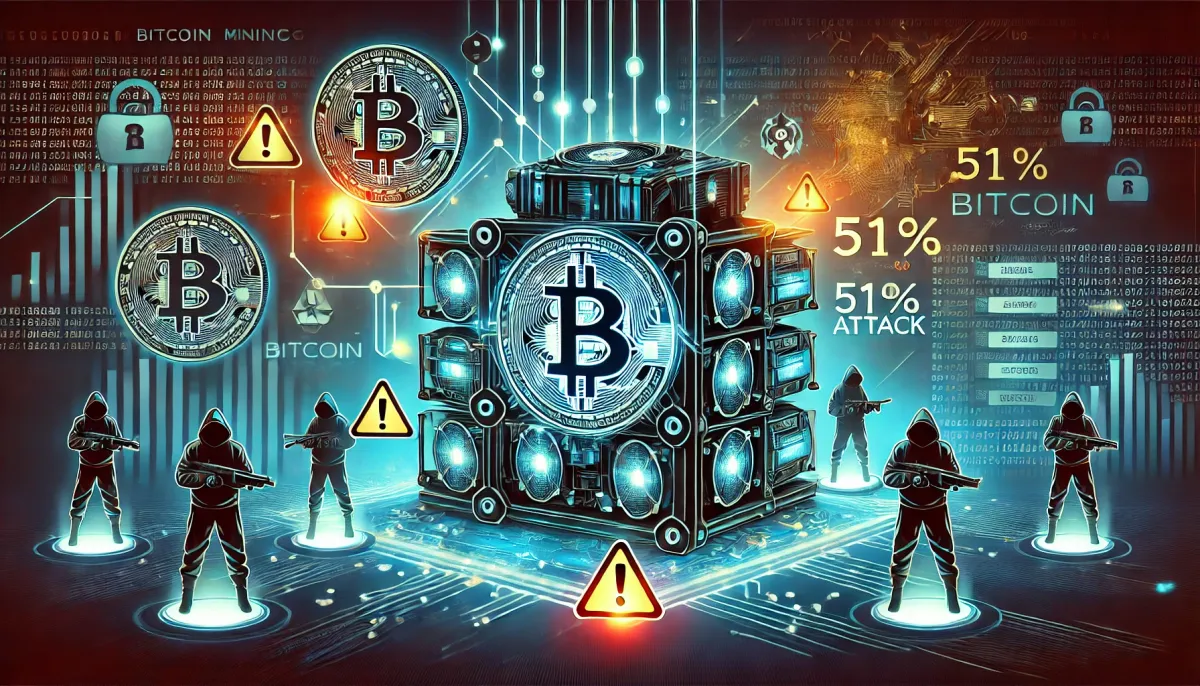Security Risks in Bitcoin Mining: 51% Attacks and Other Threats

Introduction
Bitcoin mining is the backbone of the Bitcoin network, ensuring security and transaction verification through decentralized consensus. However, despite its robust design, the mining process is not without risks. Among the most significant threats are 51% attacks, which can compromise network integrity, along with other security challenges such as selfish mining, Sybil attacks, and double-spending exploits. Understanding these risks is essential for both miners and the broader blockchain community to mitigate potential vulnerabilities.
Understanding 51% Attacks
A 51% attack occurs when a single miner or mining pool gains control of more than 50% of the total network hashrate. This level of control allows the attacker to manipulate the blockchain in several ways, including:
- Reversing transactions: The attacker can rewrite recent transaction history, potentially leading to double-spending.
- Blocking transactions: The attacker may censor certain transactions, preventing them from being included in new blocks.
- Forking the blockchain: The attacker can create a new chain that invalidates legitimate transactions on the original blockchain.
While executing a 51% attack requires enormous computational power and electricity, it remains a concern for smaller Proof-of-Work (PoW) blockchains with lower hashrates. Bitcoin, due to its immense mining power and network security, is significantly more resistant to such attacks than smaller blockchains.
Other Security Threats in Bitcoin Mining
Beyond 51% attacks, Bitcoin mining faces several other security risks:
1. Selfish Mining
Selfish mining is a strategy where a miner or a mining pool withholds discovered blocks from the network rather than broadcasting them immediately. This allows them to gain an unfair advantage by secretly extending their own blockchain and invalidating honest miners’ efforts. While Bitcoin’s current mining difficulty adjustment mechanism makes this attack challenging, it remains a theoretical concern.
2. Sybil Attacks
A Sybil attack involves an entity creating multiple fake nodes to manipulate the network’s behavior. In the context of mining, an attacker could flood the network with fake nodes to disrupt communication between miners or hinder transaction propagation. However, Bitcoin’s reliance on Proof-of-Work makes Sybil attacks costly and difficult to execute.
3. Double-Spending Attacks
A double-spending attack occurs when an attacker successfully spends the same Bitcoin twice. This can happen in several ways:
- Race attacks: The attacker sends two conflicting transactions to different recipients, hoping one is accepted before the other is detected.
- Finney attacks: The attacker pre-mines a transaction and later releases it to invalidate a prior payment.
- Vector76 attacks: The attacker exploits transaction propagation to trick a merchant into accepting an unconfirmed payment.
Confirming multiple block confirmations before accepting high-value transactions is an effective way to mitigate double-spending risks.
4. Mining Pool Centralization
While Bitcoin is designed to be decentralized, the concentration of mining power in a few large pools poses a security risk. If a single pool grows too large, it could theoretically launch a 51% attack. The Bitcoin community continuously encourages mining decentralization by supporting smaller mining pools and home miners.
5. Malware and Cryptojacking
Malware designed to hijack computing resources for unauthorized Bitcoin mining (cryptojacking) is an increasing concern. Attackers infect devices with malicious software that mines cryptocurrency without the owner’s knowledge, draining resources and increasing electricity costs. Installing security updates and using robust cybersecurity measures help protect against such threats.
Mitigation Strategies
To counter these security risks, several mitigation strategies are recommended:
- Diversification of mining pools: Miners should avoid concentrating too much power in a single pool to prevent centralization risks.
- Enhanced network monitoring: Continuous monitoring of mining activities and network health can detect and respond to potential attacks.
- Security-conscious transaction processing: Merchants and exchanges should wait for multiple confirmations before processing large transactions to reduce double-spending risks.
- Regular software updates: Keeping mining software and security tools updated helps protect against malware and vulnerabilities.
Conclusion
Bitcoin mining is a crucial component of the network, but it is not without security challenges. While a 51% attack is the most well-known risk, other threats like selfish mining, Sybil attacks, double-spending, and mining pool centralization also require attention. By understanding and addressing these vulnerabilities, the Bitcoin community can work toward a more secure and resilient network for the future.
This article presented by Loka Mining.
Loka is revolutionizing the Bitcoin mining ecosystem by directly connecting investors with Bitcoin miners through a decentralized mining pool and an upcoming permissionless forward hashrate marketplace protocol.
Loka enables investors to get Bitcoin at lower than market price without centralized & counter-party risks, and Bitcoin miners to access capital efficient financing and hedge their risk exposure by selling their future mining rewards.
Find out more about loka in https://lokamining.com — or access our mining pool aggregator on https://pool.lokamining.com





